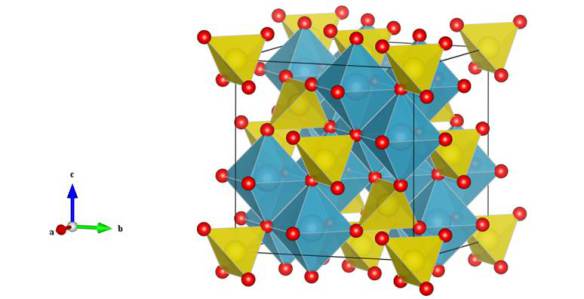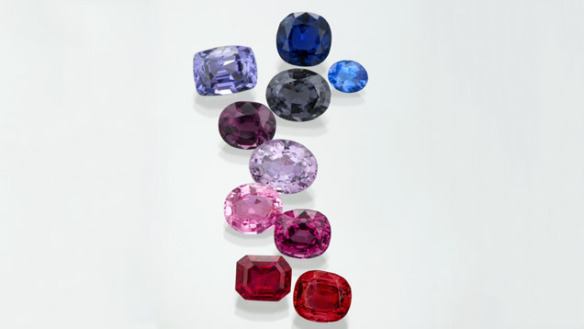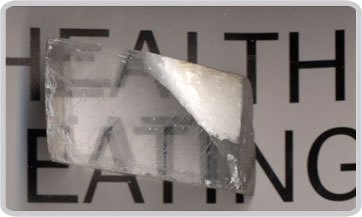The world’s most underappreciated gemstone – Red Spinel
Ruby may be the most iconic gemstone, but often this status has been at the expense of the gemstone spinel. Thanks to the similarity of red spinel to ruby and its extremely high quality, spinels have historically been overlooked and incorrectly labelled as rubies. Some of the most historically iconic rubies aren't even rubies! Spinels are so often confused with other gemstones that they were never even established as a birthstone (poor spinel).
What is Red Spinel?
The spinel structure has been described in an earlier post and MgAl2O4 is no different. Spinels consist of a nearly ideal cubic close-packed array of oxygen atoms with one eighth of tetrahedral sites occupied by magnesium and one half of octahedral sites filled by aluminium. The AlO6 octahedra share edges with each other and are corner sharing with the MgO4 tetrahedra.[1]
 Figure 1: Crystal structure of MgAl2O4. The Mg atoms sit within the yellow tetrahedra and the Al atoms sit within the blue octahedra. Image generated by the VESTA (Visualisation for Electronic and STructural analysis) software.
Figure 1: Crystal structure of MgAl2O4. The Mg atoms sit within the yellow tetrahedra and the Al atoms sit within the blue octahedra. Image generated by the VESTA (Visualisation for Electronic and STructural analysis) software.
Pure red spinel is colourless, so to obtain red spinel small quantities of chromium are substituted for aluminium, which is also the reason why rubies are coloured red. Only around 1% of chromium substituted for aluminium is required within the crystal structure to generate the brilliant red colour. However, the higher the concentration of chromium, the darker the shade of red obtained. There are actually a range of colours that spinel can adopt, depending on the foreign element substituted into the basic structure, from orange and pink to purple and deep blue. In fact, blue spinels, which are so coloured due to the presence of iron or cobalt (rarer), are often used as a substitute, and mistaken, for sapphire.[2]

Figure 2: Spinel gemstones come in a diverse range of colours. (Image obtained from http://www.gia.edu/spinel)
While rubies and sapphires are the more famous and well known gemstones, spinels are equally comparable in appearance and arguably better due to the deeper, richer colours which are more readily obtainable (especially compared with ruby). The heightened brilliance of spinels is a result of being singularly refractive. This means that the gemstone only has a single refractive index, which measures the amount by which light is slowed (and thus bent) when entering the gemstone. In comparison, the overwhelming majority of gemstones exhibit birefringence which results in the splitting of light when it enters the crystal (see below). The most well known singularly refractive gemstones are garnet, diamond and spinel.

Figure 3: An example of a crystal exhibiting birefringence. A singularly refractive crystal would only produce a single image. (Image obtain from http://www-g.eng.cam.ac.uk/CMMPE/lcintro4.html)
A chequered past
The high quality of spinels and the fact that they are compositionally similar to rubies has meant that historically they were treated as the same crystal. As a result, there are many infamous rubies which are actually just red spinels. The most well known of these is the Black Prince's ruby which is set in England's Imperial State Crown and displayed in the Tower of London. This particular gem has been passed from several Moorish and Spanish Kings before reaching Edward, Prince of Wales (the Black Prince) in 1367. The gem has survived fires, attempted theft and World War II bombing raids to become one of the centerpieces of England's Crown Jewels.[3]
Spinel applications
Spinels are not just aesthetically pleasing; they also have some interesting applications. The singularly refractive nature of spinel in combination with the relative ease of producing synthetic spinel has led to its use as high-strength window material in military applications. In addition, owing to the relative ease and low cost associated with its manufacture, spinel has come to replace the previous state-of-the-art material, sapphire.[4]
Finally, since spinels are so underappreciated, it is much cheaper than ruby! So it is possible to buy polished and cut spinel gemstones which look almost identical to rubies at a fraction of the cost. So there is some benefit to being the underdog of the gemstone world.
MgAl2O4 spinel is number 1010129 in the Crystallography Open Database.
[1] Passerini, L. Gazzetta Chimica Italiana 1930, 60, 389
[2] Shigley, J. E.; Sloclzton, C. M. Gems and Gemology 1984, 20, 34.
[3] Spinel <http://www.gia.edu/spinel> (Accessed 09/14)
[4] Mroz, T. J.; Hartnett, T. M.; Wahl, J. M.; Goldman, L. M.; Kirsch, J.; Lindberg, W. R. SPIE Proceedings 2005, 5786, 64.






